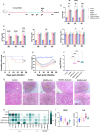Probiotic peptidoglycan skeleton enhances vaccine efficacy against MRSA by inducing trained immunity via the TLR2/JAK-STAT3 pathway
- PMID: 40755750
- PMCID: PMC12314533
- DOI: 10.3389/fimmu.2025.1606626
Probiotic peptidoglycan skeleton enhances vaccine efficacy against MRSA by inducing trained immunity via the TLR2/JAK-STAT3 pathway
Abstract
Trained immunity refers to the ability of trained innate immune cells to generate an immune memory that produces rapid, broad-spectrum, and long-lasting protection against heterologous stimuli. Based on the rapid and broad-spectrum protection that the peptidoglycan backbone from lactic acid bacteria, bacterium-like particles (BLPs), offers, we hypothesized that BLPs enhance protection through trained immunity. Here, we found that combining BLP with a vaccine significantly improves protective efficacy against methicillin-resistant Staphylococcus aureus (MRSA) infection, accompanied by changes in trained immunity markers. We demonstrate that BLP-induced trained immunity macrophages exhibit increased cytokine secretion and phagocytic activity in vitro. In an in vivo model, BLP confers protection against S. aureus 26003 even without specific antigens. In an ex vivo model, BLP induces increased markers of trained immunity. Transcriptome analysis suggests that BLP may induce trained immunity by activating the IL-6-JAK-STAT3 pathway through TLR2 receptor activation, thereby modulating macrophage metabolic reprogramming and function. In summary, our study establishes that BLP induction of trained immunity, along with regulated metabolic reprogramming and macrophage function, may contribute to enhancing vaccine efficacy. Our findings elucidate a novel mechanism for BLP-mediated immune enhancement, critical for the application of BLP as a vaccine vector to construct a vaccine that combines specific immune response with innate immune response.
Keywords: MRSA; bacterium-like particles; innate immunity; peptidoglycan backbone; trained immunity.
Copyright © 2025 Niu, Duan, Wang, Jia, Li, Guo, Zhang, Liu, Miao, Ge and Wang.
Conflict of interest statement
The authors declare that the research was conducted in the absence of any commercial or financial relationships that could be construed as a potential conflict of interest.
Figures






Similar articles
-
Pathogen-derived peptidoglycan skeleton enhances innate immune defense against Staphylococcus aureus via mTOR-HIF-1α-HK2-mediated trained immunity.Microbiol Res. 2025 Jul;296:128160. doi: 10.1016/j.micres.2025.128160. Epub 2025 Mar 29. Microbiol Res. 2025. PMID: 40174361
-
Trained Innate Immunity.Adv Exp Med Biol. 2025;1476:275-296. doi: 10.1007/978-3-031-85340-1_11. Adv Exp Med Biol. 2025. PMID: 40622547 Review.
-
Bufei Jiedu Formula enhances CD40 activation and macrophage polarization to eliminate intracellular MRSA persisters.Front Immunol. 2025 Jul 17;16:1623182. doi: 10.3389/fimmu.2025.1623182. eCollection 2025. Front Immunol. 2025. PMID: 40746551 Free PMC article.
-
Trained ILCs confer adaptive immunity-independent protection against influenza.J Virol. 2025 Aug 4:e0053225. doi: 10.1128/jvi.00532-25. Online ahead of print. J Virol. 2025. PMID: 40757858
-
Antibiotic prophylaxis for the prevention of methicillin-resistant Staphylococcus aureus (MRSA) related complications in surgical patients.Cochrane Database Syst Rev. 2013 Aug 19;2013(8):CD010268. doi: 10.1002/14651858.CD010268.pub2. Cochrane Database Syst Rev. 2013. PMID: 23959704 Free PMC article.
References
-
- Roberts RR, Hota B, Ahmad I, Scott RD, Foster SD, Abbasi F, et al. Hospital and societal costs of antimicrobial-resistant infections in a Chicago teaching hospital: implications for antibiotic stewardship. Clin Infect Diseases: an Off Publ Infect Dis Soc America. (2009) 49:1175–84. doi: 10.1086/605630, PMID: - DOI - PubMed
-
- Sievert DM, Ricks P, Edwards JR, Schneider A, Patel J, Srinivasan A, et al. Antimicrobial-resistant pathogens associated with healthcare-associated infections: summary of data reported to the National Healthcare Safety Network at the Centers for Disease Control and Prevention 2009-2010. Infection Control Hosp Epidemiol. (2013) 34:1–14. doi: 10.1086/668770, PMID: - DOI - PubMed
-
- Randolph AG, Xu R, Novak T, Newhams MM, Bubeck Wardenburg J, Weiss SL, et al. Vancomycin monotherapy may be insufficient to treat methicillin-resistant staphylococcus aureus coinfection in children with influenza-related critical illness. Clin Infect Diseases: an Off Publ Infect Dis Soc America. (2019) 68:365–72. doi: 10.1093/cid/ciy495, PMID: - DOI - PMC - PubMed
MeSH terms
Substances
LinkOut - more resources
Full Text Sources
Medical
Miscellaneous

